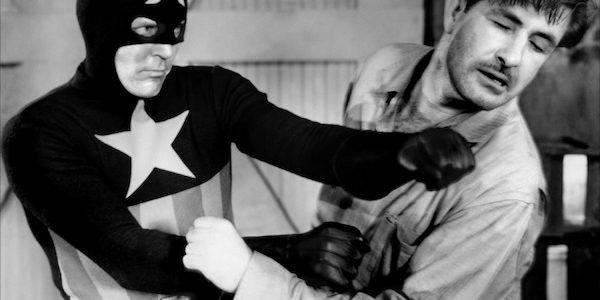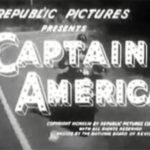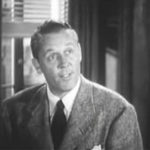
Cliffhanger Corner: ‘Captain America’ (Not the first Avenger!)
By Bob Bloom
When is a movie entitled “Captain America” not really about “Captain America?”
Quick answer: Republic Pictures 1944 15-chapter serial.
I sometimes try to imagine what kids in early 1944 felt going to a serial  titled “Captain America,” expecting to see soldier Steve Rogers, his famous shield, his young pal, Bucky, and, perhaps, even his arch-nemesis the Red Skull.
titled “Captain America,” expecting to see soldier Steve Rogers, his famous shield, his young pal, Bucky, and, perhaps, even his arch-nemesis the Red Skull.
Instead, what they saw on screen was a formulaic cops-and-robbers chapterplay that bore no resemblance to their beloved comic book hero.
In this episodic iteration, a crime wave — led by a mysterious figure known as the Scarab — is killing off prominent citizens of a major metropolitan city, and the mayor is haranguing the police commissioner and district attorney about the situation.
The D.A., Grant Gardner, assures the mayor that these crimes will be solved, and that the Scarab will be brought to justice.
Gardner, who knows the wheels of justice turn slowly, dons the costume of Captain America, a vigilante who battles crime.
So, instead of a GI battling Nazis, we have a crusading district attorney who goes outside the law to combat evil.
The Scarab is, in fact, Dr. Cyrus Maldor, curator of a museum. He is seeking revenge on members of expedition of which he was a prominent party.
Others in his group gained fame, glory and riches, while he was put in charge of a museum. I can understand his point for being bitter and seeking retribution.
Captain America was played by B-movie regular Dick Purcell, who seemed  too thick in the belly to be a masked hero. (In fact, most of the time, he wasn’t. It usually was stuntman Dale Van Sickel behind the mask).
too thick in the belly to be a masked hero. (In fact, most of the time, he wasn’t. It usually was stuntman Dale Van Sickel behind the mask).
The Scarab was played by popular horror film-character actor Lionel Atwill, who brought his usual diabolical elegance to the role of the master criminal.
The question that has dogged serial fans for a long time is, why did Republic produce a “Captain America” serial and alter the character so dramatically.
Also, why did Timely Comics (the predecessor to today’s Marvel Comics) allow Republic to so radically tamper with their character?
The answers to these questions vary, depending on the sources.
In their book, “The Great Movie Serials,” authors Jim Harmon and Donald F. Glut wrote that Republic informed Timely’s executives that “the sample comic pages sent by publishers in no way indicated that Captain America was a soldier named Steve Rogers and that he did not carry a revolver. Furthermore, since the serial was well into production, they could not and would not return to the original concept through costly retakes, nor undergo expensive and unsatisfactory dubbing of the name Steve Rogers over Grant Gardner. Since Republic was under no contractual obligations to do any of those things, the matter was closed.”
I guess the lawyers for the Timely failed to read all the fine print in their contract with Republic.
Another theory floating about for Captain America’s new identity was Republic belief that youngsters were getting tired of serials with wartime themes.
In 1943 alone, three of Republics four serials — “G-Men vs. the Black Dragon, “Secret Service in Darkest Africa” and “The Masked Marvel” all had heroes battling Axis powers.
Plus, Republic had produced “Spy Smasher” and “King of the Mounties” in 1942, in which heroes fought our nation’s enemies, plus such titles as “King of the Royal Mounted” and “King of the Texas Rangers” in which the villains were foreigners from an unnamed country — the U.S. was still neutral at the time — who were trying to wreak havoc in Canada and the United States.
Still, another hypothesis posted by Raymond William Stedman, author of “The Movie Serial Companion, Book 2” is that Republic became gun shy.
The studio originally wanted to use the Fawcett character Mr. Scarlet, a masked hero who, in his daytime job was a district attorney, as the basis for a serial, but backed away because of the legal battle between Fawcett and National Periodical over the Captain Marvel-Superman dispute, in which National sued Fawcett because of the similarities between the two superheroes.
Either way, the first movie appearance of “Captain America” is today a curiosity piece. True, it is an action-packed serial that bears no resemblance whatsoever to the character embraced by contemporary audiences.
I am a member of the Indiana Film Journalists Association. I review movies, Blu-rays and DVDs for ReelBob (ReelBob.com), The Film Yap and other print and online publications. I can be reached by email at bobbloomjc@gmail.com. You also can follow me on Twitter @ReelBobBloom and on Facebook. My movie reviews also can be found at Rottentomatoes: www.rottentomatoes.com.